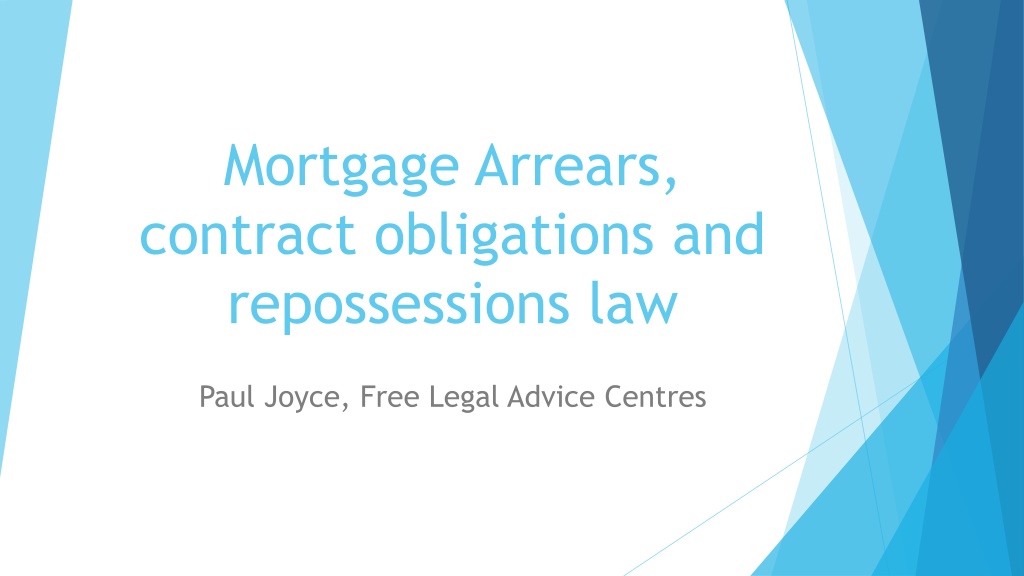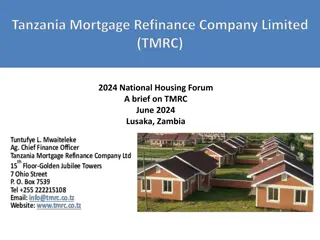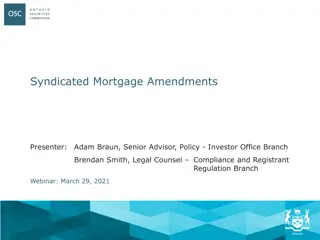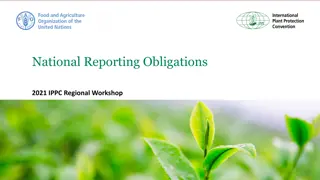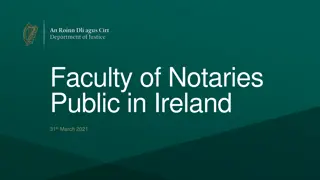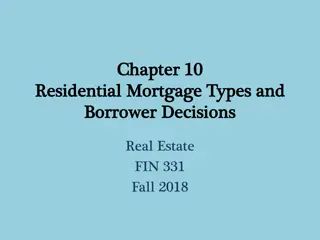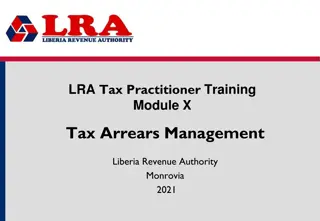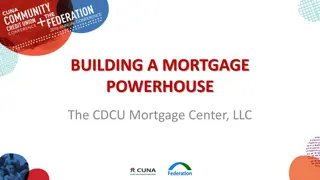Understanding Mortgage Arrears, Repossessions, and Legal Obligations in Ireland
Explore the laws surrounding mortgage arrears, repossession figures, key statistics, the Code of Conduct on Mortgage Arrears (CCMA), and legal standings in Ireland. Learn about the implications of arrears lasting over two years, the mandatory pre-litigation resolution process, and recent court rulings. Understand the balance of power between lenders and borrowers in resolving arrears and potential repossession issues.
Download Presentation

Please find below an Image/Link to download the presentation.
The content on the website is provided AS IS for your information and personal use only. It may not be sold, licensed, or shared on other websites without obtaining consent from the author. Download presentation by click this link. If you encounter any issues during the download, it is possible that the publisher has removed the file from their server.
E N D
Presentation Transcript
Mortgage Arrears, contract obligations and repossessions law Paul Joyce, Free Legal Advice Centres
Three years of repossession figures Principal Dwelling Houses only NewCases Orders Executions Surrenders 2013 3,846 626 251 515 2014 11,424 968 313 998 2015 7,902 1,517 726 809 Total 23,172 3,111 1,290 (3,612) 2,322 Source: Successive Central Bank Quarterly Reports
Key arrears statistics At end 2013, 33,589 PDH mortgages had been in arrears for over two years, 34.8% of arrears total By end 2014, this number was 37,778 and amounted to 48.0% of the total At end 2015, 36,351 were in arrears over two years and now amounted to 58.7% of the total in arrears
Code of Conduct on Mortgage Arrears (CCMA) and the MARP process Mandatory pre-litigation resolution process Lender assesses alternative repayment arrangements (ARA s) options 1) ARA offered (borrower may reject as unsuitable) 2) ARA not offered 3) Borrower deemed not co-operating Notional right of appeal against any of these substantive decisions but no independent review Complaint on process issues to FSO may delay action Balance of power remains with the lender
Legal standing of the CCMA/MARP May 2015, Supreme.Ct in Irish Life and Permanent PLC and Dunne and Dunphy found the CCMA effectively inadmissible in repossession proceedings, apart from the requirement to satisfy a moratorium before action is brought July 2015, High.Ct in Stepstone Mortgage Funding Ltd and Hughes found that the plaintiff s engaged in tick box and formulaic compliance with CCMA but granted the Possession Order as the moratorium had been complied with
Key passage from Supreme Court ruling If it is to be regarded, as a matter of policy, that the law governing the circumstances in which financial institutions may be entitled to possession is too heavily weighted in favour of those financial institutions then it is, in accordance with the separation of powers, a matter for the Oireachtas to recalibrate those laws. No such formal recalibration has yet taken place . In the absence of there being some legal basis on which it can be said that the right to possession has not been established or does not arise, then the only role which the Court may have is, occasionally, to adjourn a case to afford an opportunity for some accommodation to be reached .
Very limited defences for borrowers Dunne and Dunphy effectively negates the only potential legal defence for most borrowers in arrears who are invariably in breach of contract Land and Conveyancing Law Reform Act 2009, s.97 and 100, allow a lender to seek order for possession and sale in the event of acts of default or breach In ICS Building Society v Grant (2010) and subsequent decisions, High Court ruled out reckless lending as a tort or potential defence to repossession
Repossessions procedure By virtue of LCLR Acts 2009 and 2013, all PDH repossession cases must be brought in Cir.Ct Under s.2 LCLR Act 2013, court may of its own motion or on application adjourn for defendant to consult PIP Repossession procedure is set by S.I 264/2009 Circuit Court Rules (Actions for Possession and Well- Charging Relief) as amended by S.I 358/2012 and S.I 346/2015 Consolidation would be a help! Civil Bill served by lender with grounding affidavit returnable before the relevant County Registrar
Repossessions procedure Affidavit must identify applicable Codes, i.e. CCMA Defendant borrower may file an appearance within 10 days of service and may file replying affidavit setting out a defence at least 4 days before return date County Registrar (CR) has wide powers to extend time limits and give directions relevant to proceedings CR may grant an order where no appearance or replying affidavit is entered. Where an affidavit setting out a defence has been filed, CR shall transfer, when in order for hearing, to Judges List.
Repossessions procedure Under s.101 (1), LCLR Act 2009, where it appears that the borrower is likely to be able to pay arrears, including interest, within a reasonable period , the court may (a) adjourn proceedings or (b) where an order is granted, stay enforcement, postpone delivery of possession or suspend order at any time before enforcement wide powers in this section Orders are usually granted, after a number of adjournments, with a stay, often for 6 months. There is no reason why an extension to the stay cannot be sought and granted if good reason is provided
Relevant practice directions CC11 CC 11 (12/11/2009) Minimum of 8 weeks from issue of Civil Bill to return date. No order on return date unless defendant consents Letter must accompany Civil Bill to inform defendant of first automatic adjournment and of the importance of attendance for representations to be made concerning the proceedings Where defendant not present on the return date, a further letter must notify of the next hearing date set following the adjournment
Relevant practice directions CC17 CC 17 (10/08/2015)- Civil Bill must show jurisdiction Proofs include evidence of service on each borrower (and any occupiers over 18 years old) Certified copies of relevant correspondence required Averments to and exhibits of documents accompanying affidavit including, where a Central Bank Code, i.e. the CCMA, applies, sufficient information to enable the Court to evaluate the extent to which the plaintiff has been in compliance with the same Where mortgage has been sold, details of assignment
What is happening in practice? No write-down of secured debt taking place pre- repossession, though envisaged in the PI Act 2012 Most County Registrars are trying to avoid unnecessary repossessions by negotiation (MARP 2?) Borrower participation and bona fides essential but many (often very fearful) defendants do not appear How can this be improved? Enclosures with proceedings promoting MABS/LAB contact, public information campaigns emphasising assistance
What is happening in practice? Some borrowers have not engaged/ceased to engage and may in fact have reasonable payment capacity Negative equity (and write-off of residual mortgage debt after sale) is still a decisive factor for lenders Over time the capacity of others may have improved, but others have manifestly unsustainable mortgages Where is the expanded mortgage-to-rent scheme? Unclear also whether the new advice scheme will include assistance with petitions for bankruptcy
Conclusion Odds are firmly against the defendant borrower from a legal perspective Adjournments to consult a PIP and propose a PIA will generally be granted Where the borrower engages, repossession is generally a last resort Lender paperwork is sometimes not in order. This at least allows time for the situation to potentially improve In short, the advocate s job is to seek to avoid the unnecessary repossession of family homes through vigilance, persuasion and co-operation with other services
